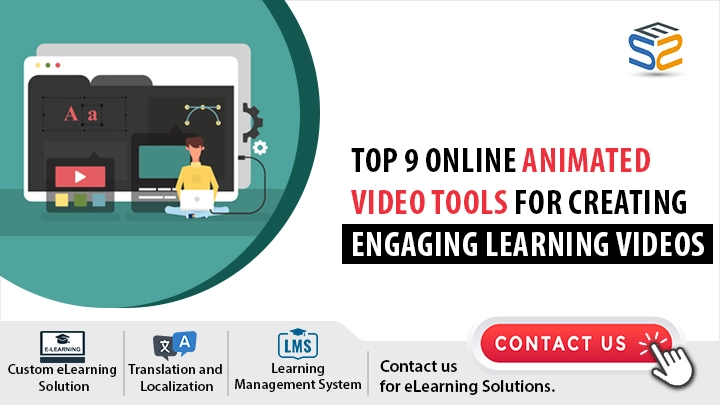Introduction
The digital era has revolutionized online learning, making learning more accessible than ever. With the rise of online courses, educators are constantly searching for new ways to engage learners and make complex information easier to understand. This is where animated videos come into play. These dynamic, visually appealing tools are not just entertaining-they’re also incredibly effective at enhancing comprehension and retention.
In this article, we’ll explore the top nine online animated video tools that can help you create captivating learning videos for your online courses. Whether you’re a seasoned educator or just starting out, these tools will empower you to produce high-quality animations that can transform the learning experience.
Why Use Animated Videos for Learning?
Animated videos do more than just add visual appeal-they play a crucial role in learning. By combining visuals with storytelling, they make content more engaging and easier to understand. Here’s why they’re particularly effective:
- Engaging Visual Content: Animated videos capture attention more effectively than text, helping learners stay focused throughout their sessions.
- Simplifies Complex Concepts: Animation can break down intricate ideas into simple, digestible visuals, enabling learners to grasp difficult topics more quickly.
- Enhances Retention and Recall: The blend of visual and auditory elements in animated videos aids in memory retention, ensuring learners remember more of what they’ve learned.
- Versatility in Learning Environments: Animated videos can be utilized in various settings, from traditional classrooms to online courses, making them highly adaptable teaching tools.
What are the Key Features to Look for in an Animated Video Tools
Before exploring the top tools, it’s important to understand what features make an animated video tool suitable for creating effective learning content:
- User-Friendly Interface: The tool should be intuitive and easy to use, even for those new to video creation.
- Customization Options: Opt for tools that offer a range of templates, characters, and backgrounds that you can customize to fit your specific learning content.
- Integration with Other Tools: Ensure the tool can seamlessly integrate with platforms like LMS (Learning Management Systems) to streamline the learning process.
- Export Options and File Formats: The tool should support multiple export formats and resolutions, allowing you to choose the best option for your needs.
- Pricing Plans and Free Trials: Look for tools that offer free trials or affordable pricing plans, especially if you’re working within a budget.
1. Vyond
Overview and Key Features
Vyond is one of the leading animated video tools available today. It’s known for its user-friendly interface and extensive library of templates, characters, and props. Vyond allows users to create professional-looking animations with ease, making it a favorite among educators and businesses alike. The platform supports various styles, including whiteboard animations, 2D animations, and even infographic videos.
| Pros | Cons |
|---|---|
|
|
Ideal Use Cases
Vyond is ideal for creating explainer videos, training materials, and marketing content. It’s perfect for educators who want to create engaging and informative videos without needing advanced technical skills.
2. Powtoon
Overview and Key Features
Powtoon is another popular tool that simplifies the process of creating animated videos. It offers a variety of templates and styles, from cartoonish animations to sleek, professional designs. Powtoon is highly intuitive, making it accessible even to those with no prior animation experience. The platform also offers real-time collaboration features, which is great for team projects.
| Pros | Cons |
|---|---|
|
|
Ideal Use Cases
Powtoon is perfect for creating short, engaging videos for learning content, social media, and presentations. It’s particularly useful for educators who need to produce videos quickly and efficiently.
3. Animaker
Overview and Key Features
Animaker is designed for users who want to create animated videos without any prior experience. It offers a drag-and-drop interface and a vast library of pre-made characters, backgrounds, and sound effects. Animaker also allows users to create videos in multiple formats, including horizontal, vertical, and square, which is perfect for social media sharing.
| Pros | Cons |
|---|---|
|
|
Ideal Use Cases
Animaker is ideal for creating animated videos for social media, learning purposes, and marketing campaigns. It’s especially useful for educators looking to create engaging content quickly and easily.
4. Moovly
Overview and Key Features
Moovly is a versatile tool that caters to both beginners and advanced users. It offers a wide range of customizable templates and a library of over 1 million free media objects. Moovly’s unique selling point is its ability to integrate with other platforms, such as YouTube and Vimeo, for easy sharing and publishing.
| Pros | Cons |
|---|---|
|
|
Ideal Use Cases
Moovly is great for educators and businesses that need a flexible tool for creating a wide variety of video types, from explainer videos to more complex animations.
5. Renderforest
Overview and Key Features
Renderforest is a cloud-based tool that offers more than just video creation. It’s an all-in-one platform for branding, providing users with the ability to create logos, websites, and videos. The video creation tool includes a vast array of templates, making it easy to produce professional-quality animations quickly.
| Pros | Cons |
|---|---|
|
|
Ideal Use Cases
Renderforest is perfect for educators who want to create animated videos as part of a broader branding strategy. It’s also ideal for small businesses that need a comprehensive tool for marketing and learning content.
6. Biteable
Overview and Key Features
Biteable is known for its simplicity and speed. It’s designed for users who need to create videos quickly, offering a range of pre-made scenes and templates. Biteable’s interface is straightforward, making it easy to produce professional-looking videos in minutes. The platform is particularly suited for creating short, shareable content.
| Pros | Cons |
|---|---|
|
|
Ideal Use Cases
Biteable is perfect for educators and marketers who need to create quick, engaging videos for social media, advertisements, or short learning modules.
7. VideoScribe
Overview and Key Features
VideoScribe specializes in whiteboard animations, which are particularly effective for learning content. The tool allows users to create hand-drawn style animations that can simplify complex concepts. VideoScribe’s drag-and-drop interface is intuitive, and it offers a wide range of hand-drawn images and templates.
| Pros | Cons |
|---|---|
|
|
Ideal Use Cases
VideoScribe is ideal for educators who need to break down complex ideas into simple, digestible content. It’s particularly effective for explainer videos and tutorial content.
8. Toonly
Overview and Key Features
Toonly is a user-friendly tool focused on creating 2D animated explainer videos. It’s perfect for users who want to create engaging, story-driven content without a steep learning curve. Toonly offers a library of characters, scenes, and props, making it easy to create professional-looking animations.
| Pros | Cons |
|---|---|
|
|
Ideal Use Cases
Toonly is perfect for educators and marketers who want to create narrative-driven explainer videos that captivate audiences.
9. Wideo
Overview and Key Features
Wideo is designed for users who need to create professional-quality videos quickly. It offers a drag-and-drop interface and a variety of templates for different types of videos, including explainer videos, presentations, and advertisements. Wideo also allows for easy customization, making it suitable for a range of use cases.
| Pros | Cons |
|---|---|
|
|
Ideal Use Cases
Wideo is ideal for educators and businesses that need to create professional-looking videos for presentations, marketing, or online courses quickly and efficiently.
How to Choose the Best Tool for Your Needs
Consider Your Audience
The first step in choosing the right tool is understanding your audience. Are they students, professionals, or casual learners? Different tools offer varying levels of sophistication, so choose one that aligns with your audience’s needs.
Budget and Pricing
Your budget will also play a significant role in your decision. While some tools offer free versions, they often come with limitations like watermarks or restricted features. Evaluate your budget and determine which tool offers the best value for money.
Ease of Use
If you’re new to video creation, you’ll want a tool with a simple, intuitive interface. Tools like Powtoon and Animaker are great for beginners, while more advanced users might prefer the flexibility of Vyond or Moovly.
Integration and Export Options
Finally, consider how the tool integrates with other platforms you use, such as Learning Management Systems (LMS), social media, or video sharing sites. Also, check the export options to ensure your videos can be easily shared and used across different platforms.
Conclusion
Animated videos have become an essential component of online learning, providing a dynamic way to engage learners and simplify complex concepts. With the right tool, creating these videos can be both easy and enjoyable. Whether you’re looking for something simple like Biteable or more advanced like Vyond, there’s a tool out there to meet your needs.
Investing in the right animated video tool can transform your online learning courses, making them more engaging, effective, and enjoyable for your students.
Frequently Asked Questions (FAQs)
Q1. What are the benefits of using animated videos in online learning?
A. Animated videos make learning more engaging and help simplify complex concepts, which enhances comprehension and retention.
Q2. Can these tools be used by beginners?
A. Yes, many of these tools are designed with beginners in mind, offering intuitive interfaces and easy-to-use templates.
Q3. Are there free versions of these tools?
A. Yes, most of these tools offer free versions, though they often come with limitations such as watermarks or restricted features.
Q4. How long does it take to create an animated video?
A. The time required depends on the complexity of the video and your familiarity with the tool. Simple videos can be created in a few hours, while more complex ones may take longer.
Q5. Which tool is best for professional-quality videos?
A. Vyond and Moovly are excellent choices for those looking to create professional-quality videos with a range of customization options.




